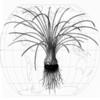| Publication Type: | Journal Article |
| Year of Publication: | 2016 |
| Authors: | E. Larsen, Rydin C. |
| Journal: | International Journal of Plant Sciences |
| Volume: | 177 |
| Pagination: | 157–174 |
| Abstract: | Premise of research. The heterosporous lycopsids of Isoetes show limited morphological and genetic variation despite a worldwide distribution and the ancient origin of the lineage. Here major relationships within the genus are clarified, using a substantially larger sampling of species than in previous studies. A first assessment of divergence times of clades is made, and the implications for dispersal mechanisms and biogeographic distribution patterns are discussed. Methodology. On the basis of sequences from three gene regions and 109 specimens representing 74 species of Isoetes, phylogeny and node ages were estimated using parsimony and Bayesian inference. Pivotal results. Three rooting approaches (outgroup analysis, midpoint rooting, and clock rooting) coherently resolved a diverse clade containing species from South Africa, India, Australia, and South America (clade A) as sister to remaining Isoetes. Analysis of divergence times of clades yielded a median age of the crown group of 147 million years ago (mya) using a birth-death tree prior and 165 mya using a Yule tree prior. Clade A was dated to 111 or 125 mya, respectively. While the earliest divergences in Isoetes appear readily explained by ancient vicariance, patterns in younger clades are consistent with dispersal processes, sometimes over long distances. Isoetes andicola (Amstutz) L.D. Gómez, once hypothesized to represent a separate lineage and assigned to the genus Stylites, is here included in a phylogenetic study for the first time. It is closely related to some other South American species, despite its peculiar morphology with a dichotomizing stem. Conclusions. Despite limited intrageneric variation at the molecular and morphological levels, node ages as well as species composition (phylogeny) indicate a Mesozoic origin of the extant clade. Biogeographic patterns appear complicated and intriguing but need more research. Tuberculate megaspore ornamentation (sensu Pfeiffer) is ancestral in the genus, as indicated by current knowledge. Other megaspore patterns appear restricted to two subclades. |
